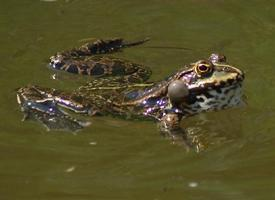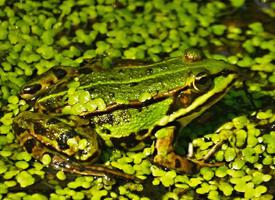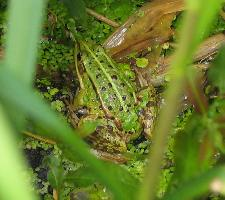
Greutăți și măsuri
| Lungime | de la 4,7 la 11,6 cm |
|---|
Date biologice
| Durata de viață | de la 18 la 20 ani |
|---|
Descrierea animalului
The Agile Frog (Rana dalmatina) is a fascinating and somewhat elusive amphibian that is native to Europe. It is part of the Ranidae family, which includes many of the world's most familiar frog species. The Agile Frog is known for its remarkable leaping abilities and distinctive physical characteristics that set it apart from other frog species.One of the most striking features of the Agile Frog is its slender and elongated body, which can reach up to 9 cm in length for females, slightly larger than the males. This sleek body shape aids in its agility, allowing it to make impressive leaps, sometimes covering distances of over 2 meters. Its skin is smooth and varies in color from reddish-brown to grayish-brown, providing excellent camouflage among the forest floor and leaf litter where it predominantly resides.
The limbs of the Agile Frog are long and powerful, with the hind legs being particularly well-developed for jumping. Its feet are partially webbed, which not only aids in swimming but also in its remarkable leaping ability. The toes have small, round pads that help the frog grip surfaces as it lands.
Another distinguishing feature of the Agile Frog is its eyes, which are large and protruding, with a distinctive horizontal pupil. This gives the frog a wide field of vision, crucial for detecting predators and prey. The eyes also contribute to the frog's keen sense of sight, which, along with its sensitive hearing, makes it an adept hunter.
The Agile Frog's diet primarily consists of various invertebrates, including insects, spiders, and worms. Its long, sticky tongue is perfectly adapted for catching fast-moving prey with precision.
Breeding season for the Agile Frog occurs in early spring. Males call to attract females with a quiet, croaking sound. Females lay their eggs in shallow, still water bodies, such as ponds or ditches. The eggs are laid in large clusters and are attached to vegetation under the water. After about two weeks, the eggs hatch into tadpoles, which undergo metamorphosis into frogs over the next few months.
The Agile Frog prefers habitats that are moist and covered with dense vegetation, such as deciduous forests, forest edges, and meadows. It is also sometimes found in more open landscapes, provided there are suitable breeding sites and enough cover for protection.
Despite its agility and adaptability, the Agile Frog faces several threats, including habitat destruction, pollution, and climate change. These factors have led to declines in some populations, making conservation efforts important for ensuring the species' survival.
In conclusion, the Agile Frog is a remarkable amphibian with unique adaptations that make it an agile jumper and an efficient predator. Its slender body, powerful legs, and keen senses enable it to thrive in a variety of habitats, although it faces threats from human activities. Conservation efforts are crucial to protect this fascinating species and the ecosystems it inhabits.
Animale similare
Fotografii noi cu animale
Top 10 animale
- Dolphin gull (Leucophaeus scoresbii)
- Diana monkey (Cercopithecus diana)
- Moustached guenon (Cercopithecus cephus)
- Galápagos tortoise (Geochelone nigra complex)
- Japanese macaque (Macaca fuscata)
- Stone loach (Barbatula barbatula)
- Russian tortoise (Testudo horsfieldii)
- Greek tortoise (Testudo graeca)
- Common flying dragon (Draco volans)
- Vendace (Coregonus albula)


